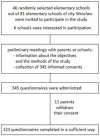Familial Correlates of Leisure Time Activities among Polish Early School-Age Children: A Cross-Sectional Study
- PMID: 33916306
- PMCID: PMC8036540
- DOI: 10.3390/ijerph18073704
Familial Correlates of Leisure Time Activities among Polish Early School-Age Children: A Cross-Sectional Study
Abstract
The after-school period may play a critical role in the accumulation of children's physical activity and sedentary time. The study aimed to characterize familial correlates of early school-age children's leisure time activities. A cross-sectional study was conducted among a group of 223 children (mean age 8.7 ± 0.5) and their parents. The percentage of children with daily leisure time physical activity (LTPA) >1 h was 23.32%, and with daily screen time <2 h was 32.74%. The average children's leisure time physical activity was significantly higher on weekend days than on weekdays (114.85 vs. 89.43 min, p = 0.005). Similarly, the average screen time was higher on weekend days than on weekdays (95.50 vs. 66.10 min, p < 0.001). The multivariate regression analysis revealed that independent predictors of children's leisure time physical activity were the father's education level and the father's occupational status, whereas at least one parent with higher education correlated negatively with children's longer screen time. The study showed that children's leisure time activities are associated with parental education and differ significantly between weekdays and weekend days. These findings underline the need for screening for unfavorable health behaviors among early school-age children, and indicate that health promotion programs should be oriented on both parents and children aiming to improve parental health consciousness, reduce screen time and increase physical activity, especially during the weekend.
Keywords: leisure time; lifestyle; physical activity; school-age children; screen time.
Conflict of interest statement
The authors declare no conflict of interest.
Figures





Similar articles
-
Health-related parental indicators and their association with healthy weight and overweight/obese children's physical activity.BMC Public Health. 2018 May 31;18(1):676. doi: 10.1186/s12889-018-5582-7. BMC Public Health. 2018. PMID: 29855285 Free PMC article.
-
Young children's after-school activities - there's more to it than screen time: a cross-sectional study of young primary school children.J Phys Act Health. 2015 Jan;12(1):8-12. doi: 10.1123/jpah.2013-0075. Epub 2014 Feb 5. J Phys Act Health. 2015. PMID: 24510028
-
Weekday-weekend variations in mother-/father-child physical activity and screen time relationship: A cross-sectional study in a random sample of Czech families with 5- to 12-year-old children.Eur J Sport Sci. 2018 Sep;18(8):1158-1167. doi: 10.1080/17461391.2018.1474951. Epub 2018 May 23. Eur J Sport Sci. 2018. PMID: 29792130
-
Family and home influences on children's after-school and weekend physical activity.Eur J Public Health. 2013 Oct;23(5):805-10. doi: 10.1093/eurpub/cks160. Epub 2012 Nov 20. Eur J Public Health. 2013. PMID: 23172732 Free PMC article.
-
Correlates of Total and domain-specific Sedentary behavior: a cross-sectional study in Dutch adults.BMC Public Health. 2020 Feb 12;20(1):220. doi: 10.1186/s12889-020-8316-6. BMC Public Health. 2020. PMID: 32050958 Free PMC article.
Cited by
-
Children's and Families' Determinants of Health-Related Behaviors in an Italian Primary School Sample: The "Seven Days for My Health" Project.Int J Environ Res Public Health. 2022 Jan 1;19(1):460. doi: 10.3390/ijerph19010460. Int J Environ Res Public Health. 2022. PMID: 35010721 Free PMC article.
-
Step by Step: Investigating Children's Physical Activity and Enjoyment in Outdoor Walking with Their Parents.Healthcare (Basel). 2025 Jul 17;13(14):1721. doi: 10.3390/healthcare13141721. Healthcare (Basel). 2025. PMID: 40724746 Free PMC article.
-
Stigma perception and health fatalism in parents of children with epilepsy: A cross-sectional study.Heliyon. 2024 Aug 3;10(15):e35525. doi: 10.1016/j.heliyon.2024.e35525. eCollection 2024 Aug 15. Heliyon. 2024. PMID: 39170317 Free PMC article.
-
Associations of family socioeconomic indicators and physical activity of primary school-aged children: a systematic review.BMC Public Health. 2024 Aug 19;24(1):2247. doi: 10.1186/s12889-024-19174-6. BMC Public Health. 2024. PMID: 39160508 Free PMC article.
References
-
- Carson V., Hunter S., Kuzik N., Gray C.E., Poitras V.J., Chaput J., Saunders T.J., Katzmarzyk P.T., Okely A.D., Connor Gorber S., et al. Systematic review of sedentary behaviour and health indicators in school-aged children and youth: An update. Appl. Physiol. Nutr. Metab. 2016;41:S240–S265. doi: 10.1139/apnm-2015-0630. - DOI - PubMed
-
- World Health Organization . Global Recommendations on Physical Activity for Health. World Health Organization; Geneva, Switzerland: 2010. pp. 17–21. - PubMed
MeSH terms
LinkOut - more resources
Full Text Sources
Other Literature Sources
Medical

